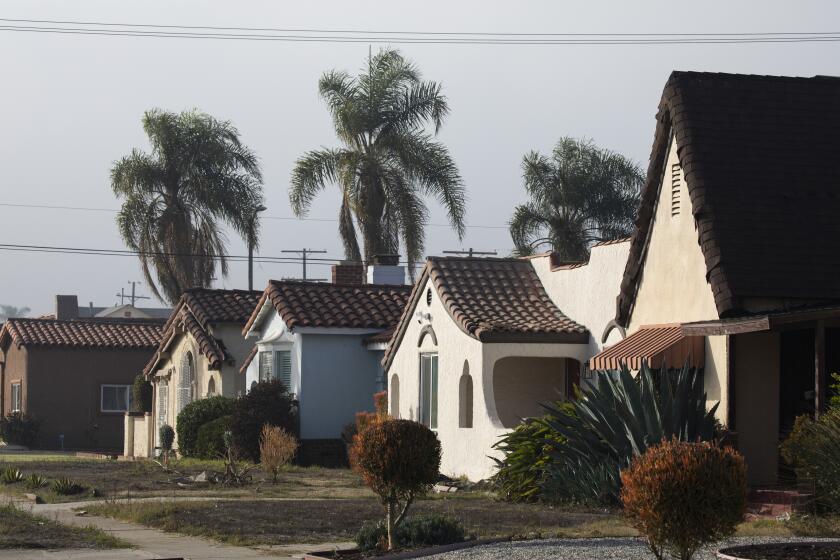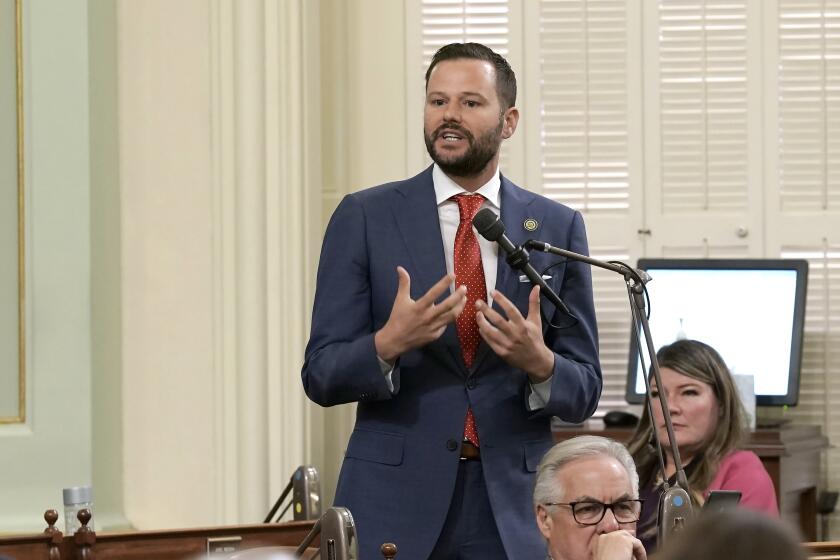
Even though California has experienced lopsided out-migration for decades, the financial blow has been cushioned by the kinds of people moving into the state: The newcomers were generally better educated and earned more money than those who left.
Not now: That long-standing trend has reversed. New state-to-state migration data show that for several years, thousands more high-earning, well-educated workers have left California than have moved in.
The reversal, largely in response to the state’s high taxes and soaring cost of living, has begun to damage California’s overall economy. And, by cutting into tax revenues, has delivered punishing blows to state and local governments.
State budget analysts recently projected a record $68-billion deficit in the next fiscal year because of a 25% drop in personal income tax collection in 2023. Some city, county and other local taxing authorities, particularly in the San Francisco Bay Area, have also recorded revenue declines.
With investors and high-income taxpayers receiving substantial compensation in the form of stocks, last year’s sluggish stock market accounted for a major share of the decline in state income tax revenues. So did layoffs and financial weakness in the tech sector.
See which California cities are the most costly to live in. Several studies agree: The premium to live in California may be 40% to 50% over the national average.
But rising unemployment in the state and the growing flight of professionals, business operators and others making good salaries were also notable contributors. And those factors will be harder to reverse, at least in the foreseeable future.
“There’s a price to pay for the movement of middle- and upper-income people and corporations,” said Joel Kotkin, a fellow at Chapman University who has researched the flight from California and the resulting threat to the state’s fiscal outlook. “People who are leaving are taking their tax dollars with them.”
The accelerating exodus from California in recent years, of both companies and people, has been well documented. The pandemic-induced rise in remote work, inflated housing prices and changing social conditions have spurred more Californians to pull up stakes.
Last year, Soo-Jin Yang moved herself and her designer-eyelash business from Oakland to Las Vegas. Yang, 45, was born, grew up and went to college in the East Bay, but she said she no longer felt safe operating her company in downtown Oakland. She also wanted an easier place to do business; Nevada has fewer regulations and no personal income tax.
“Definitely the tax breaks, more affordable wages,” said Yang, who founded her beauty firm, Illumino, in 2007 and now has six employees, one of whom moved with her from California to Nevada.
In 2021 and 2022, about 750,000 more people left the state than moved in, according to recently released Census Bureau data. That was about as many as the total net loss of residents for all five years before the COVID-19 pandemic in early 2020.
But it’s not just the sheer numbers of people who have left. What’s different is that in each of the prior two years, more than 250,000 Californians with at least a bachelor’s degree moved out, while an average of 175,000 college graduates from other states settled in California, according to an analysis of census data by William Frey, a demographer at the Brookings Institution.
Gov. Gavin Newsom said his staff has been working with Democrats in the Legislature on the state’s healthcare minimum wage law in light of budget concerns.
In prior periods over the last two decades, that balance was about even or slightly in California’s favor, even though the state consistently lost many more residents overall to other states than it gained from them. The recent out-migration has been particularly pronounced among Californians with graduate and professional degrees.
California is heavily dependent on high earners to meet government fiscal needs. Tax filers in the top 1% of income, earning around $1 million and above, have typically accounted for 40% to 45% of the state’s total personal income tax revenue, said Brian Uhler, deputy legislative analyst at California’s Legislative Analyst’s Office, which estimated the $68-billion budget deficit.
But it’s not just the super rich such as Elon Musk, who moved from California to Texas in 2020 and brought his company Tesla with him a year later, or movie star Mark Wahlberg, who left Los Angeles for Vegas last year. There’s been a broader exodus of ordinary Californians in the upper-income spectrum as well.
In the tax filing years 2020 and 2021, the average gross income of taxpayers who had moved from California to another state was about $137,000. That was up from $75,000 in 2015 and 2016, according to migration and personal income data from the Internal Revenue Service.
Californians moving to Nevada hope to re-create a California lifestyle — a tech hub with mountain views — without the Golden State’s problems. It’s not working exactly as planned.
IRS and other data show that Texas has long been, by far, the top destination for Californians. And in the years 2015-16, an individual or couple who had moved from California to Texas reported an average income of $78,000, about the same as Texans who relocated to California. But by 2020-21, California transplants in Texas reported an average income of about $137,000, while tax returns from former Texans who moved to California showed an average income of $75,000.
The income gap between those coming into California and those going out is even bigger when it comes to Florida, which, as far away as it is, has become a top five destination for emigrating Californians. Statistics show more older Californians are likely to move there. Florida, like Texas and Nevada and Tennessee, another more recent hot spot for Californians, doesn’t have a personal income tax.
In California, the top tax rate for personal income is 12.3%.
“They’re saying, ‘Hey, I’m working hard and the income tax is just killing me,’” said Todd Litman, a longtime estate planning attorney in Tustin.
These days, Litman says, he’s hearing from four or five clients every month who want to leave California, up from just one a month a few years ago. Many of his clients have $1 million or more in their retirement accounts, he said, and don’t want the extra tax burden when they make withdrawals.
After trying out Pasadena, Atlanta and Miami, Lilian Junco decided this was the place to retire.
The 2017 federal tax cut backed by President Trump also has spurred more moves by high-income Californians, according to research by Stanford finance professor Joshua Rauh. That tax change put a $10,000 cap on state and local tax deductions, which for many Californians more than offset savings from the federal tax cut because of their higher state personal income and property taxes.
California’s big and progressive tax on incomes could be a persistent drag on migration, especially as baby boomers continue to retire and look to shelter their savings.
But that’s not all. California’s pricey housing market is likely to keep driving more Californians elsewhere. Although trending lower in recent months, the median price of a single-family house in the state in October was $840,360, up 46% from the start of 2020, according to the California Assn. of Realtors.
Moody’s Analytics economist Mark Zandi analyzed moves in and out of California for The Times using Equifax credit data, to zero in on the age of the movers. He found that since the pandemic in early 2020, California has lost residents in every age group, but by a significant margin the biggest net out-migration came from those 35 to 44 years old.
“This is probably motivated by the severe housing affordability crisis in California,” Zandi said. “It’s all but impossible for them to become homeowners in the state.”
Eric McGhee, a senior fellow at the Public Policy Institute of California, who has written about demographic trends in migration, thinks the increased loss of higher-educated Californians to other states in recent years can be traced in significant part to the rise of remote work since the pandemic. As more employers call workers back to the office, and the share of fully remote work appears to have settled at around 10% of all employees, McGhee expects the net out-migration from California to slow.
Opinion: The $1-million home is becoming the norm in L.A. This is an outrage we could have prevented
California’s median home price is near $750,000. The most promising prescription for the housing shortage is undoing single-family zoning and increasing density.
Although the number of people leaving the state is small as a share of California’s overall population of about 39 million, McGhee said, “it’s a significant issue because the numbers add up over time.” What’s more, with the pandemic and immigration restrictions imposed by Washington, California hasn’t had the same stream of new arrivals from foreign countries, many from Asia with advanced degrees, as it had in the past to backfill the negative domestic migration.
Even if the outflow of residents reverts to pre-pandemic levels, the broader economic climate doesn’t bode well for the state’s budget and economic outlook, at least in the immediate future.
The U.S. economy is slowing, and California’s economy is decelerating faster than the nation’s, with the state’s unemployment rate, most recently at 4.8%, already a full point higher than nationwide.
California is more dependent on interest-sensitive sectors such as real estate and high tech, especially startups. Silicon Valley emerged from the pandemic awash in venture money and with a burst of investments, but sharply rising interest rates beginning in spring 2022 pummeled tech stocks and new investments, causing layoffs and shrinking capital gains taxes. Sales tax revenue in California also has dried up, despite higher prices from inflation.

Subscribers get exclusive access to this story
We’re offering L.A. Times subscribers special access to our best journalism. Thank you for your support.
Explore more Subscriber Exclusive content.
For now, the Legislative Analyst’s Office is projecting a small improvement in income tax revenue over the next two years, but that’s cold comfort for policymakers and economists. California has $24 billion in rainy day general funds, less than half of what’s needed to cover the expected shortfall.
“It’s probably going to be some combination of cutting back spending and raising taxes,” Sung Won Sohn, an economics professor at Loyola Marymount University, said of the likely response to the budget crisis. “But if we keep raising taxes,” he added, “we’ll keep chasing people away from the state.”
More to Read
Sign up for This Evening's Big Stories
Catch up on the day with the 7 biggest L.A. Times stories in your inbox every weekday evening.
You may occasionally receive promotional content from the Los Angeles Times.















